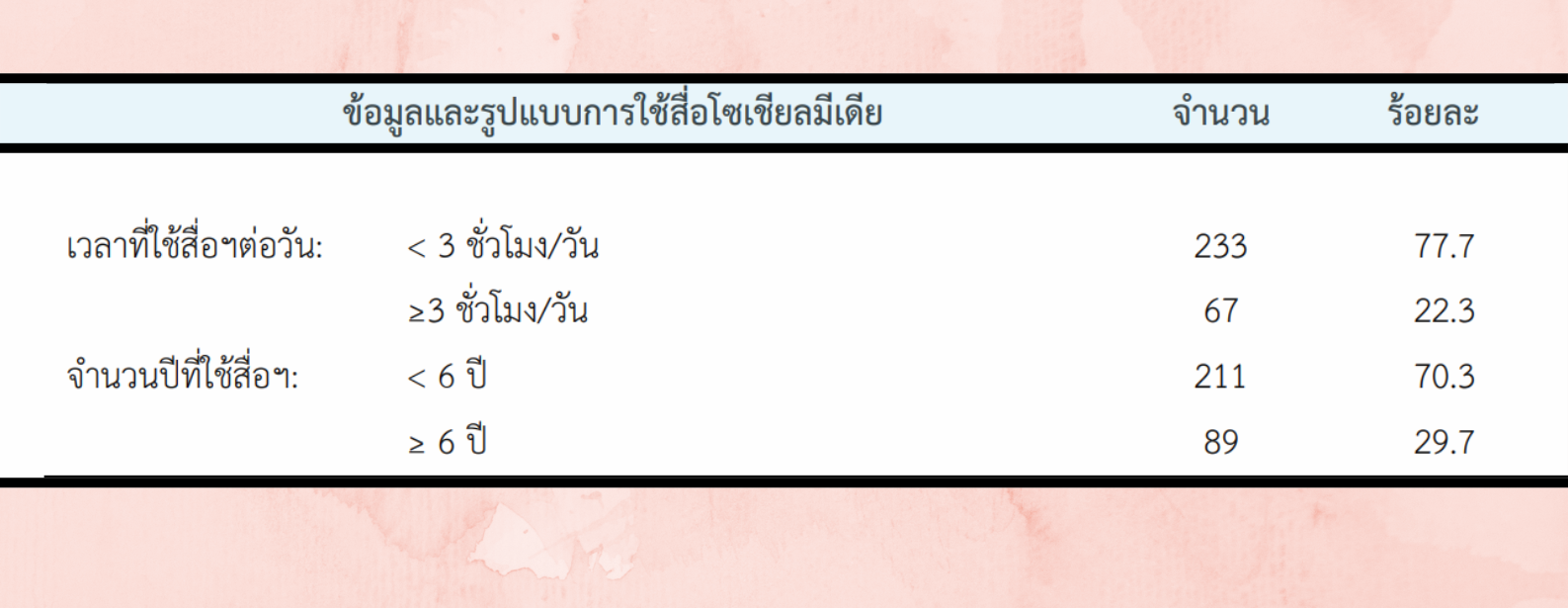ความชุกและความสัมพันธ์ระหว่างการติดสื่อโซเชียลมีเดียกับภาวะซึมเศร้าและ วิตกกังวลในผู้สูงอายุที่มารับบริการที่คลินิกตรวจโรคเวชศาสตร์ครอบครัว โรงพยาบาลพระมงกุฎเกล้า
คำสำคัญ:
การติดสื่อโซเชียลมีเดีย, ภาวะซึมเศร้า, ภาวะวิตกกังวล, ผู้สูงอายุบทคัดย่อ
การศึกษาแบบภาพตัดขวางมีวัตถุประสงค์เพื่อศึกษาหาความชุกและความสัมพันธ์ระหว่างการติดสื่อโซเชียลมีเดียกับภาวะซึมเศร้าและวิตกกังวลในผู้สูงอายุเก็บข้อมูลจากกลุ่มตัวอย่างที่มีอายุ 60 ปีขึ้นไป ที่มารับบริการที่คลินิกตรวจโรคเวชศาสตร์ครอบครัว โรงพยาบาลพระมงกุฎเกล้า ระหว่างเดือนเมษายน ถึง กรกฎาคม 2563 โดยวิธีสุ่มจำนวน 300 คน เครื่องมือที่ใช้วิจัย คือ แบบสอบถามข้อมูลทั่วไป แบบสอบถามการติดสื่อโซเชียลมีเดีย และแบบสอบถามวัดอาการซึมเศร้าและวิตกกังวล วิเคราะห์ข้อมูลโดยใช้สถิติเชิงพรรณนา ได้แก่ จำนวน ร้อยละ ค่าเฉลี่ย หาความสัมพันธ์โดยสถิติไคสแควร์ค่าสัมประสิทธิ์ความสัมพันธ์ของเพียร์สัน และสมการถดถอยโลจิสติกส์
ผลการศึกษาพบว่ากลุ่มตัวอย่างมีอายุเฉลี่ย 66.04 ± 5.06 ปี ใช้งานสื่อโซเชียลมีเดียเฉลี่ย 2.21± 1.3 ชั่วโมงต่อวัน มีความชุกของการติดสื่อโซเชียลมีเดียระดับความเสี่ยงสูงร้อยละ 5 ความชุกของภาวะซึมเศร้าและวิตกกังวลร้อยละ 9 และ 12.3 ตามลำดับ ค่าสัมประสิทธิ์ความสัมพันธ์ของเพียร์สันระหว่างการติดสื่อโซเชียลมีเดียกับภาวะซึมเศร้าและวิตกกังวลเท่ากับ -0.248(P<0.001) การทดสอบด้วยสมการถดถอยโลจิสติกส์พบว่ากลุ่มตัวอย่างที่มีการติดสื่อโซเชียลมีเดียในระดับความเสี่ยงต่ำ จะมีภาวะซึมเศร้าและวิตกกังวลสูงกว่ากลุ่มตัวอย่างที่มีความเสี่ยงการติดสื่อโซเชียลมีเดียระดับปานกลาง และระดับสูง 15.13 เท่า และ 6.08 เท่า ตามลำดับ
สรุปการติดสื่อโซเชียลมีเดียกับภาวะซึมเศร้าและวิตกกังวลในผู้สูงอายุมีความสัมพันธ์กันอย่างมีนัยสำคัญทางสถิติแต่ก็พบปัจจัยอื่นๆที่อาจมีผลต่อภาวะซึมเศร้าและวิตกกังวลด้วย เช่น โรคประจำตัว ปัญหาครอบครัว ปัญญาหาเศรษฐกิจและสังคม เป็นต้น ดังนั้นควรมีการศึกษาเพิ่มเติมเพื่อหาแนวทางที่เหมาะสมในการใช้สื่อโซเชียลมีเดียที่มีความสัมพันธ์กับภาวะซึมเศร้าและวิตกกังวลในผู้สูงอายุต่อไป
เอกสารอ้างอิง
Acciai, F., Hardy, M., (2017). Depression in later life: a closer look at the gender gap. Sos Sci Res, 68 : 163-75.
Ariel, S., Jaime, ES., Mary, AD., César, GE., Brian, AP. Social Media Use and Depression and Anxiety
Symptoms: A Cluster Analysis. Am J Health Behav 2018;42(2):116–28.
Blazer, DG, & Steffens DC. (2009). Demography and epidemiology of psychiatric disorder in late life. In: Blazer DG, Steffens DC editors. Textbook of Geriatric Psychiatry. (4th ed.). North Carolina: American psychiatric publishing:19-43.
Boonmesrisanga, M. & Sodchuen, M. (2017). The Patterns of Using Social Media in Bangkok. The 9th Rajamangala University of Technology National Conference(PP.1598-1605). Nontaburi. Rajamangala University of Technology. (in Thai)
Bryant, C., Jackson, H. & Ames, D. (2008). The prevalence of anxiety in older adults: meothodological issues and review of the literature.Journal of Affective Disorders,3:233-250.
Buntadthong, K.(2015). Social Network Usage Behavior and Bangkok Older Person’s Satisfaction. M.Com.Arts (Strategic Communications), May 2015, Graduate School,Bangkok University.
Charoensak, S., Sittironnarit, G., Satra, T., Muangpaisan, W., Srinontprasert, V.(2018). Prevalence of Psychiatric Disorders in Elderly Patients, Quality of Life of Patients and Caregivers, and Their Correlated Factors. J Psychiatr Assoc Thailand 2018; 63(1): 89-98(in Thai)
Cole, MG. & Dandukuri, N.(2003). Risk factors for depression among elderly community subjects : a systematic review and meta-analysis. Am J Psychitry ,160:1147-56.
Dendukuri, N. & Cole, M. (2009). Risk Factors for Depression Among Elderly Community Subjects: A Systematic Review and Meta-Analysis. The American Journal of Psychiatry, 60(6):1147-1156.
Electronic Transactions Development Agency (Public Organization).(2018). Electronic Transactions Development Agency Report 2018. Bangkok: Ministry of Digital Economy and Society. (in Thai)
Jiranukool, J.(2015). Depression and Anxiety among Elderly Patients with Chronic Disease at the Faculty of Medicine, Mahasarakham University Hospital. J Sci Technol MSU,35(1):94-101
Kaja, C., Thapinta, D. & Skulphan, S.(2018). The Relationship between Facebook Addiction and Depression among Adolescents Attending State University in Chiang Mai Province. The Southern College Network Journal of Nursing and Public Health,5(2):57-69. (in Thai)
Kessler, RC., Berglund, P., Demler, O., Jin, R., Merikangas, KR. & Walters, EE. (2005). Lifetime Prevalence and Age-of-Onset Distributions of DSM-IV Disorders in the National Comorbidity Survey Replication. Arch Gen Psychiatry, 62(6): 593–602.
Kittirattanapaiboon, P., Tantirangsee, N., Chutha, W., Tanaree, A., Kwansanit, P., Assanangkornchai, S., et al. (2013 , Prevalence of mental disorders and mental health problems: Results from Thai national mental health survey 2013.(P.45).Department of mental health:Beyond Publishing. (in Thai)
National statistical office. (2018). Report on the 2017 of the Survey of the Older Persons in Thailand. Bangkok: Ministry of Digital Economy and Society. (in Thai)
National statistical office. (2018). Report Quarte4 on the 2018 of the Survey the use of information technology; And household communication. Bangkok: Ministry of Digital Economy and Society. (in Thai)
Nilchaikovit, T., Lortrakul, M. & Phisansuthideth, U. (1996). Development of Thai version of Hospital Anxiety and Depression Scale in cancer patients. Journal of the Psychiatrist Association of Thailand, 41(1):18-30. (in Thai)
Nimrod, G. (2010). Seniors' online communities: a quantitative content analysis. Gerontologist, 50 (3). 382-392.
Pernsungnern, P., Pornnoppadol, C., Sitdhiraksa, N. & Buntub, D. (2014). Social media addiction: prevalence and association with depression among 7th – 12th Grade Students in Bangkok. Graduate Research Conference 2014; 2014 Mar 28; Khom Kaen,Thailand. Khon Kaen University: 1132-1139.
Sadock, BJ. & Sadock, VA. (2003) Geriatric psychiatry in synopsis of psychiatry. (9th ed.). Philadelphia: Lippincortt Williams & Willkins.
Sassarini, DJ. (2016).Depression in midlife woman. Maturity, 94:149-54.
Shannon, A. & Chen, TY. (2018). Online Social Participation Buffers the Relationship Between Pain and Depression. The Journals of Gerontology, 74(6):1020–1031.
Siriumpankul, A. (2018). Depression and Social Media Behavior. Panyapiwat Journal, 10: 327-337 (in Thai)
Somvatasan, K. (2016). The study of communication behaviour in Line Application data sharing of elderly people. Master of Art (Communication Art and Innovation). National Institute of Development Administration. (In Thai)
Wanrtongkum, S., Sucharitakul, P., Wongjaroen, S., Maneechompoo, S., (2008). Prevalence of depression among a population aged over 45 years in Chiang Mai, Thailand. J Med Assoc Thai, 91(12): 1812-6. (in Thai)
Wolitzky-Taylor, KB., Castriotta, N., Lenze, EJ., Stanley, MA. & Craske MG. (2010). Anxiety Disorders in Older Adults: A Comprehensive Review. Depression and Anxiety, 27:190-211.
Udomratn, P.(2001). Anxiety Patient. Handbook of care for people with mental health and psychiatric problems for doctors. (PP1-7).Bangkok: Radiation Company Limited Publisher.
Yoelao, D.(2015). Development of community models and mechanisms for the care and prevention of depression and anxiety disorders in the elderly. Bankok: Foundation of Thai Gerontology Research and Development institute (TGRI). (in Thai)

ดาวน์โหลด
เผยแพร่แล้ว
รูปแบบการอ้างอิง
ฉบับ
ประเภทบทความ
สัญญาอนุญาต
ลิขสิทธิ์ (c) 2022 วารสารสาธารณสุขและวิทยาศาสตร์สุขภาพ

อนุญาตภายใต้เงื่อนไข Creative Commons Attribution-NonCommercial-NoDerivatives 4.0 International License.
บทความทุกบทความที่ได้รับการตีพิมพ์ถือเป็นลิขสิทธิ์ของ วารสารสาธารณสุข















